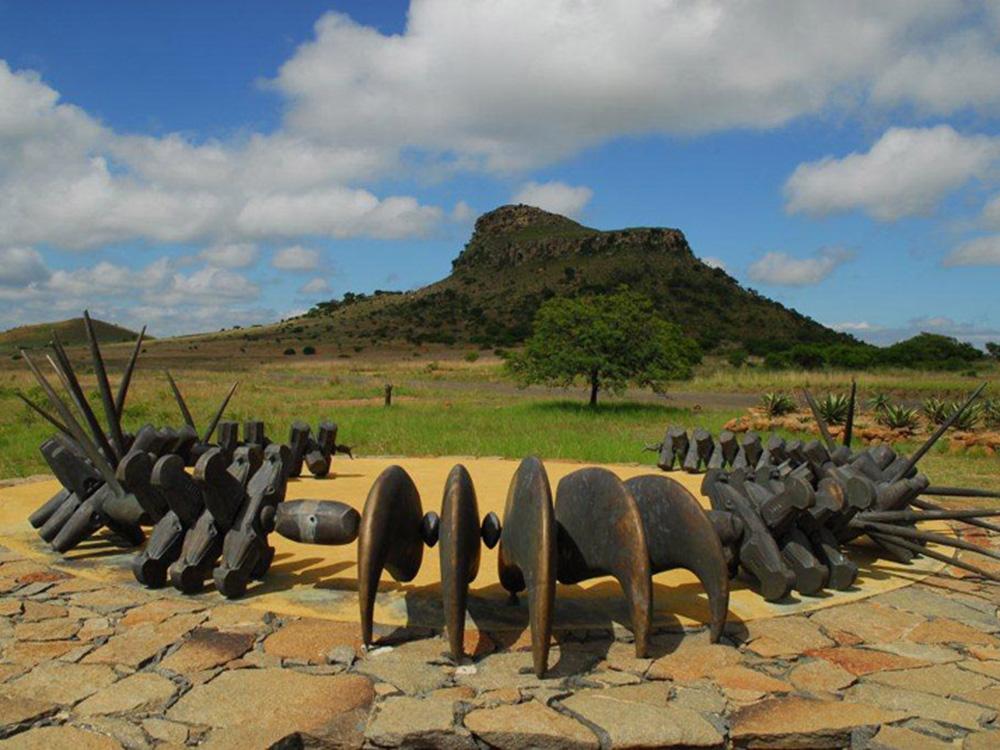
Disclaimer: Any views expressed by individuals and organisations are their own and do not in any way represent the views of The Heritage Portal. If you find any mistakes or historical inaccuracies, please contact the editor.
A casualty rate of 10% of forces engaged in battle is today considered as catastrophic. British casualties at Isandlwana number some 70%, which constitutes annihilation. Zulu numbers have always been exaggerated, but current thinking is approximately 3000 dead out of an attacking force of about 20000, which works out at more than 10%. So the battle may also be considered catastrophic for the Zulus, although they did come away with the entire contents of the camp, which was their ultimate objective.
Zulu King Zwelithini has asked on a number of occasions why the names of the Zulu dead are not recorded somewhere? The answer is that there were no written records at that time, and thus the names have sadly blown away into the winds of history.
In 1999 a monument to the Zulu dead was erected at Isandlwana to coincide with the 120th Anniversary of the battle. It consists of a gigantic representation of a warrior’s necklace or isiQu, the Zulu equivalent of a campaign medal. A “been there, got the T shirt” award, NOT the so-called “Zulu VC” so beloved by some historians. Traditionally the necklace is either made by cutting up one’s walking stick and stringing the blocks together or else specifically from imsimbithi wood (Natal Olive).
The necklace is shaped in the bull’s horn formation, pointing towards the hill where the warriors died. Around the base are a number of sleeping pillows or iziqiki, symbolizing that the warriors are “sleeping”, and this is thus a monument to the dead warriors.
Unfortunately, it failed to hit its mark. The iziqiki are not correct – they are of a West African pattern.
Luckily, there is a second, far simpler memorial at Isandlwana: a tree, Ziziphus Mucronata to be precise, more commonly called the Buffalo Thorn, or Umpafa or Lathlamkhosi. The reasoning behind this memorial is simple:
- It is a living thing that looks after itself.
- Its leaves and berries are highly nutritious for wild animals as well as domestic livestock.
- Concoctions of the roots and leaves will cure boils and open sores, act as a painkiller and are useful in the treatment of dysentery. Infusions of the bark are used to treat chest and respiratory complaints.
- The buds, when made into a herbal tea, apparently cause a urinary tract infection which can only be cured by sexual intercourse, which causes pregnancies, and thus this tree is the giver of life.
- The double-hooked barbs are used to capture the ancestral spirit of a warrior killed in battle by dipping a twig into the stomach cavity of the deceased and symbolically “hooking” the spirit in order to take it home.
Thus this tree is a living thing that requires no maintenance, feeds your animals and cures you of various ailments. Could there be a more fitting memorial?
About the author: Pat Rundgren was born in Kenya and grew up in what was then Bechuanaland and Rhodesia. He has nearly 10 years infantry experience as a former member of the Rhodesian Security Services. He is passionate about and has a deep knowledge of the battles, the bush and Zulu culture. He has written numerous articles on military subjects and militaria collecting for overseas publications, has contributed to several books and is currently busy with his eighth book. His wide ranging knowledge and over 20 years guiding experience and unique story telling will bring events alive to his listeners. His books “What REALLY happened at Rorke’s Drift?” and on Isandlwana and Talana have gone into a number of reprints. He is a collector of militaria with special focus on medals. He also organises and conducts tours around the battlefields of KwaZulu-Natal and tours into Zululand to experience traditional and authentic Zulu culture and life style. Pat is currently the Chairperson of the Talana Museum Board of Trustees and one of the volunteer researchers.
Comments will load below. If for any reason none appear click here for some troubleshooting tips. If you would like to post a comment and need instructions click here.
